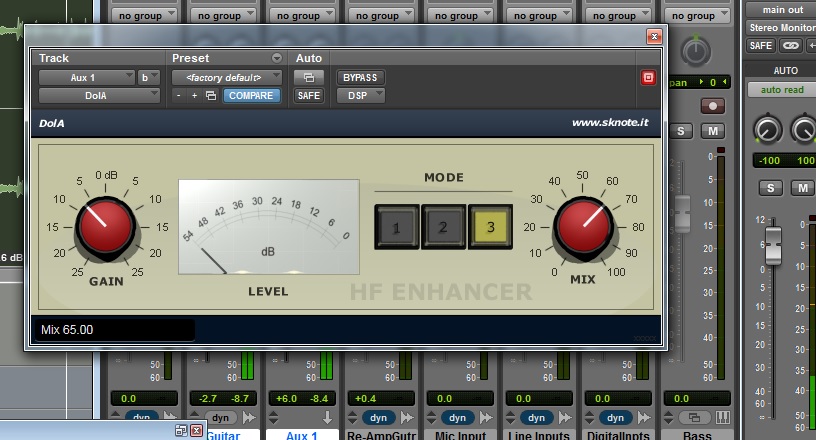DolA is an extremely simple processor, apparently, it requires a good understanding of what is happening for the best results, though.
It is based on a vintage trick: a noise reduction processor, used in its “encoding” or “rec” mode, is used as enhancer to open the sound of a track, mix or master. The result is interesting because the processor operates on frequency bands, independently but with two partially overlapping bands, and can provide an extremely transparent action if well set up. Originally, the effect wasn’t designed to be heard but required the complimentary effect in the listening system, to (almost) null it with the net result of an increased signal/noise ratio.
The effect is a combination of multiband processing, limited compression (compression with a limit to the action of the gain reduction amplifier), limiting, saturation. Simplifying, the net result is to bring up a dynamic region of a frequency band, dinamically. Being a combination of non linear effects the input level defined the behaviour of the system. Gain staging is actually a parameter for this effect.
DolA makes it extremely simple with its input Gain knob. It is compensated at the output, to avoid level changes, and is internally patched in reverse. The reason is that with this routing it can be used like a “processed average level” control. Increase Gain to move the effected dynamic range up. Decrease it to move the effected range down.
The Gain setting is very important to make the best use of the effect: almost (apparently) inaudible but missing once bypassed. The main feeling is like removing a blanket from the speakers.
These are a few rules of thumb for a fast start-up.
- Start with Mix full CW. The effect is mixed at its max level and can be easily set up. Reduce Mix when all the parameters are set.
- Start with Gain full CW. The effect is more blatant because the range of action is high, so it processes the highest (and easily audible) part of the signal.
- Start with Mode 0. It is more audible, processes a wider frequency range. Try Mode 1: too subtle? Go back to Mode 1.
- Try Mode 2 the last. It is not an original hack of the hardware unit but an original algorithm.
- Move Gain CCW until you think you are not hearing the effect anymore. Then increase it a bit. Or, try to focus on the level range when it is operating. Easier on a short loop.
- The effect is immediately addictive. Compare dry/wet continuously while setting the parameters.
The Mix knob adds effect to the dry source. It goes to 200% effect, though, so you can still use it as a send effect. Actually this is an interesting subject.
There are three possible uses of DolA: insert on a track, insert on a group, send. Being it a non-linear effect (more than that, a parallel-series combination of non linear effects) everything changes depending on the position in the chain. These are a few ideas about possible placement and different results.
- Insert on a track. The effect is driven by the single track source, it is the most straight-forward result. What happens when several instances are used on several tracks playing together? Their action is independent, each one depending on its own source. The overall enancement (and resulting frequencies added to the mix) has a randomly variable level.
- Insert on a group. The effect is driven by the sub-mix of tracks. The average effect could be smoother.
- Send, receiving from several tracks (probably different instruments). The effect is driven from a less homogeneus sub-mix. The effect will “fill holes” left by a bigger part of the mix. Could be the most transparent effect.
- Insert on the master channel or on a mix. On an increasing scale from point 1 above to this, probably the most transparent effect.
The best one? 1 when an instrument needs “life”, 2 on multitracks like a drums group, 3 to open a submix, 4 to refine an almost perfect balance.
